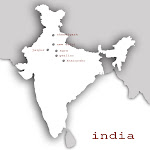





This morning we woke up with much anticipation for our visit to the Taj Mahal. Our personal tour guide for the day was a man by the name of Bobby. An interesting side note is that for the entire day as our guide he charged us 650 rupees. This equates to around 13 American dollars. I was more than a little blown away. In addition, we also visited a carpet making factory and observed this hand crafted art. The gentleman showing us around showed us a 10 foot by 12 foot carpet. The price was 1,800 U.S. dollars. He explained that it would take three people one year to make such a rug; and then another couple of months for trimming, cleaning and drying. Can you imagine working on something for a year in your meager hut on the outskirts of town, in the dirt, working your fingers numb and then that carpet is sold for $1,800? I didn’t dare ask what the workers were paid to create such an item – I am sure it was next to nothing.
Well back to the architecture. The Taj Mahal is truly amazing. The story goes that the Emperor’s wife had complications with the birth of her second daughter and while on her death bed she made her husband promise her three things. 1. Never marry again. 2. Make sure that their children were very well taken care of. 3. When she was dead that he would build the greatest monument ever constructed to her. He completed all three. The basic structure of the Taj Mahal took 7 years to construct and the white marble and detail work took an additional 15 years to complete; making the total construction time 22 years. In contrast to the poverty of the city and country this building is indeed one of the Seven Wonders of the World. A great architectural competition was instigated by the Emperor and an architect from Iran was chosen. Every part of the Taj was designed to have perfect symmetry and balance. The only part of the Taj that is not symmetrical is the placement of the tomb of the Emperor. His wife’s tomb is on the center line and his is adjacent to the west side of hers. Originally the Emperor had planned to build a black Taj Mahal across the river, but as construction began the Emperor’s son imprisoned his father and would not allow it to be built. The Emperor was kept in the Jasmine Tower at Agra Fort overlooking the Taj Mahal; only allowed to leave to visit the Taj to pay tribute to his wife. At the end of our tour my dad and I spent about an hour resting in the shade gazing up at the Taj. The structure is so simple yet the detailing is so complex.
After visiting the Agra Fort we traveled to the opposite side of the river so I could sketch. I forgot to mention that the security personnel would not allow me to bring my sketchbook into the Taj complex, so I was unable to sketch the Taj from the front. I guess in some way this was a good thing; without this restriction I probably wouldn’t have made it a point to go to the other side of the river to view the Taj. Once in position on the north side of the river I found a place to sit on a little piece of concrete. It started off as a comfortable spot but gradually over the next hour became a somewhat painful place to be sitting. I began twice sketching the Taj and it just was not coming out right. Finally I told myself to stop thinking and worrying about the sketch and to just draw! Slowly over the next hour the sketch began to come together. Often children would come up to talk and look at what I was doing. When I first began sketching in public places I would get nervous when people would look over my shoulder, but slowly I have learned to appreciate the attention.


























